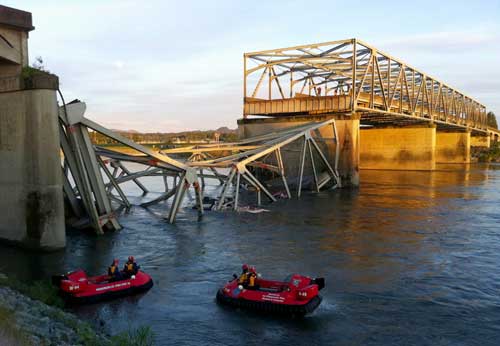Download PDF
RCA TRAINING
Root Cause Analysis training by Sologic provides the tools, skills, and knowledge necessary to solve complex problems in any sector, within any discipline, and of any scale. Learn MoreSOFTWARE
Sologic’s Causelink has the right root cause analysis software product for you and your organization. Single users may choose to install the software locally or utilize the cloud. Our flagship Enterprise-scale software is delivered On Premise or as SaaS in the cloud. Learn MoreDISCLAIMER: the contents of this RCA report and chart were taken from the National Transportation Safety Board (NTSB)'s investigation report and the University of Illinois at Urbana Champaign analysis. Sologic did not participate in the investigation, or the development of the solutions for this analysis.
 On May 23, 2013, at approximately 7:05 pm PDT, a truck-tractor in combination with a flatbed semitrailer hauling an oversize load (the oversize vehicle) was traveling south on Interstate 5 (I-5) near Mount Vernon, Washington. The oversize vehicle had a permit for the route of travel and was being led by a pilot/escort vehicle. As the oversize vehicle traveled across the I-5 bridge above the Skagit River, it struck the bridge, damaging its structure. As a result of contact damage to the bridge’s truss structure, span 8 of the 12-span bridge collapsed into the Skagit River. Two passenger vehicles fell into the river. Two other vehicles were also damaged during the event. Eight vehicle occupants were involved in the bridge span collapse; three received minor injuries and five were uninjured.
On May 23, 2013, at approximately 7:05 pm PDT, a truck-tractor in combination with a flatbed semitrailer hauling an oversize load (the oversize vehicle) was traveling south on Interstate 5 (I-5) near Mount Vernon, Washington. The oversize vehicle had a permit for the route of travel and was being led by a pilot/escort vehicle. As the oversize vehicle traveled across the I-5 bridge above the Skagit River, it struck the bridge, damaging its structure. As a result of contact damage to the bridge’s truss structure, span 8 of the 12-span bridge collapsed into the Skagit River. Two passenger vehicles fell into the river. Two other vehicles were also damaged during the event. Eight vehicle occupants were involved in the bridge span collapse; three received minor injuries and five were uninjured.In order to prevent further collapses on this bridge, the bridge was rebuilt with an 18-foot clearance over all lanes and it has been recommended that the Federal Highway Administration develop a guide for eliminating or reducing bridge strikes. To prevent impacts such as this on other similar bridges, the Illinois analysis recommends selectively adding supports in key areas to distribute the load in the event of a collision. They also recommend automatic notifications from the pilot car's antenna to the truck driver, and to update the Department of Transportation's bridge database to reflect the lowest vertical height for all bridges.
The bridge collapse was caused by a semi truck impacting a truss and multiple braces with sufficient force to fracture the bridge. The truck impacted the truss and multiple braces because it was traveling in the outside lane which was shorter in height than the inside lane. The truck was traveling in outside lane because the driver was unaware that the inside lane was designed for taller vehicles, he moved to right lane to let another truck pass, and the pilot car did not communicate the clearance issue.
The driver was unaware of the lane height differences because his vehicle received a permit for the route, despite this particular bridge clearance being lower than the truck's height, there were no warning signs for clearance height, and no one informed the driver about differences in clearance in outside/inside lanes. The vehicle received a permit for a bridge, despite bridge clearance being lower than truck's height because the DOT automatically issues permits online, Washington DOT only keeps the maximum clearance in its bridge database, and a bridge database is used to issue permits. There were no warning signs for the clearance height because signage is not required by law for bridges over 14 feet (4.26m).
The pilot car did not communicate clearance issues because the pilot car driver did not notice the antenna low-clearance detection, or because there was no low clearance detection by antenna (unclear which was the case). Regardless, the truck was following the pilot car too closely to react, even if escort had noticed and communicated. The driver did not notice the potential antenna low-clearance detection because the driver was distracted - talking on cell phone. There was potentially no low clearance detection by the antenna because the antenna was not straight, so it was not accurately measuring the full height. There was sufficient force to fracture the bridge because the mass of the truck was 88,700 lbs, its speed was approximately 60 mph, and the bridge was built using a fracture-critical, through truss design. Fracture-critical design means that failure of an essential part can cause overload/collapse. A through truss bridge design was used because it was a common bridge design when bridge was built in 1955.